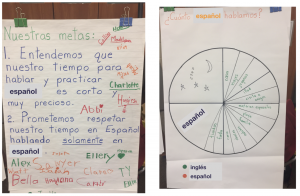By: Stacey Vanden Bosch

In part 1 of this blog post, “to separate or not to separate,” I explain why I agree with Dr. Aradhana Mudambi about the importance of teachers separating instructional languages to maintain the integrity of dual language education programs. I also take it a step further and explain WHY separation is also important for students.
In part 2 of “to separate or not separate,” I. . .
- explain what the separation of languages means in the Language First approach.
- offer more reasons why it is important.
- share three steps to get you started.
separation of languages in the Language First approach
Some experts in the field, like Dr. José Medina, have historically opposed the separation of languages. Dr. Medina expresses concern that separating languages has the potential to further linguistic oppression and stop students from drawing on their entire linguistic repertoire. In reality, when done through the Language First approach it does the opposite.
By expecting and celebrating the exclusive use of Spanish during Spanish instructional time, teachers send the message that Spanish IS the language of school rather than a mere stepping stone toward academic achievement in English. By encouraging students to make cross-linguistic connections while remaining in Spanish, teachers provide students with MORE opportunities to build metalinguistic awareness and improve Spanish proficiency levels.
Take a peek at this lesson in which the teacher encourages her students to make a connection to English while remaining in Spanish. It’s obvious that students are drawing on their entire linguistic system and building metalinguistic awareness without a word of English being spoken.
more reasons to separate languages
Remember what I say in part 1 of “to separate or not to separate? “Both emerging bilinguals, Spanish and English dominant students tend to prefer English. And while “Spanglish” may be a superpower in the United States due to the growing population of bilinguals, it is not so in other countries. If we want our dual language students to have opportunities in a global marketplace, they need “monolingual” proficiency in more than one language.
And, when students don’t fully develop their Spanish language proficiency, we hear things like this from dual language teachers in all different contexts from 50/50 two-way to early-total one-way programs: “It’s impossible to keep my students in Spanish.” Or, “When academic concepts become more difficult, I find myself using more English to make sure they understand.”
I completely commiserate. Until Lilah (my co-founder) and I developed the Language First approach and with it our Language of Instructional Only Policy and Timeline (LIOPT), we felt the same. But, after the first year of implementing LIOPT, that all changed. Here’s what happened.
We could walk into any classroom and hear ONLY Spanish – even amongst the students when they were working collaboratively in groups. For students, one obvious result was that their proficiency increased. And with greater proficiency seemed to come a greater sense of pride in their identity as bilingual learners. We observed students chatting in Spanish as they walked out of their classrooms or during lunch where as before, conversations took place in English. Instead of gravitating toward English books in the library, students began checking out more Spanish books. In turn, the teachers had to scaffold less when the content became complex. And it was no longer a constant fight to keep students in Spanish. What started as an expectation simply became the norm.
But those results weren’t exclusive to just our schools, since first implementing LIOPT, we’ve helped thousands of dual language immersion teachers get the same results in their own programs. And you can too.
getting started
- Examine your beliefs about what students can do
Our beliefs inform our practice. If we don’t believe students are capable of remaining in Spanish during Spanish instructional time, they won’t. Changing our beliefs takes time, but we can do it. Did you know that simply speaking out loud the new beliefs we are trying to adopt 100 times, can begin to rewire our brains? Each morning before heading to school, stand in front of a mirror and say aloud, “I believe my students are capable of developing high proficiency levels in Spanish and English and I will expect nothing less.”
- Make LIOPT clear to the adults
Make sure the adults at school and home understand the importance of the separation of languages to promote higher levels of Spanish proficiency. Use information from part one and part two of the “to separate or not to separate” blog posts as well as LIOPT itself to foster buy-in. Having support from your dual language and mainstream colleagues as well as from families sends the message that everyone is on the same page about prioritizing Spanish. Students will notice when the adults in their lives prioritize Spanish and follow suit.
- Make LIOPT clear to students
Once the adults are clear, it’s important to make it clear to students. To do that, you can go use one for the LIOPT mini-lessons linked here (one-way lesson plan OR two-way lesson plan). Use the lesson plans and classroom contracts to support implementation.
The lesson plan displays a pie chart visual to show students the percentage of time they spend in school learning in Spanish versus the amount of time they spend outside of school exposed to English. After students begin to understand that only a small sliver of time is actually dedicated to Spanish, they agree to protect that time by using Spanish with the teacher and one another. To formalize the agreement, students sign a contract that is visually displayed for the remainder of the year.

Another lesson plan you can use explains the idea of circumlocution, or talking around a word – not to be evasive but to describe it (circumlocution lesson plan link here). For example, if students don’t know a word in Spanish such as “whale,” they can use what they do know to describe it or even gestures and charades without resorting to English. They can do the same for unknown English words. Circumlocution empowers students to use the language they feel less confident in.
Better yet, you can work with your administrative team to enroll in our Language First certification courses (see below). You’ll learn more about LIOPT and how to prioritize Spanish language and literacy through the implementation of classroom and program- level strategies that:
- engage students with the Spanish language through contextualization, awareness, and practice experiences during content instruction.
- empowers students through corrective feedback that increases accuracy.
- builds students’ metalinguistic awareness without compromising proficiency through cross-linguistic connections.
For students to reach the goal of bilingualism and biliteracy that looks like this:

We need to create environments in our dual language immersion programs that look like this:

Curious to learn more about our LIOPT and our Language First approach, watch our webinar here. Or contact us to learn more about our resources and Language First Certification courses.


